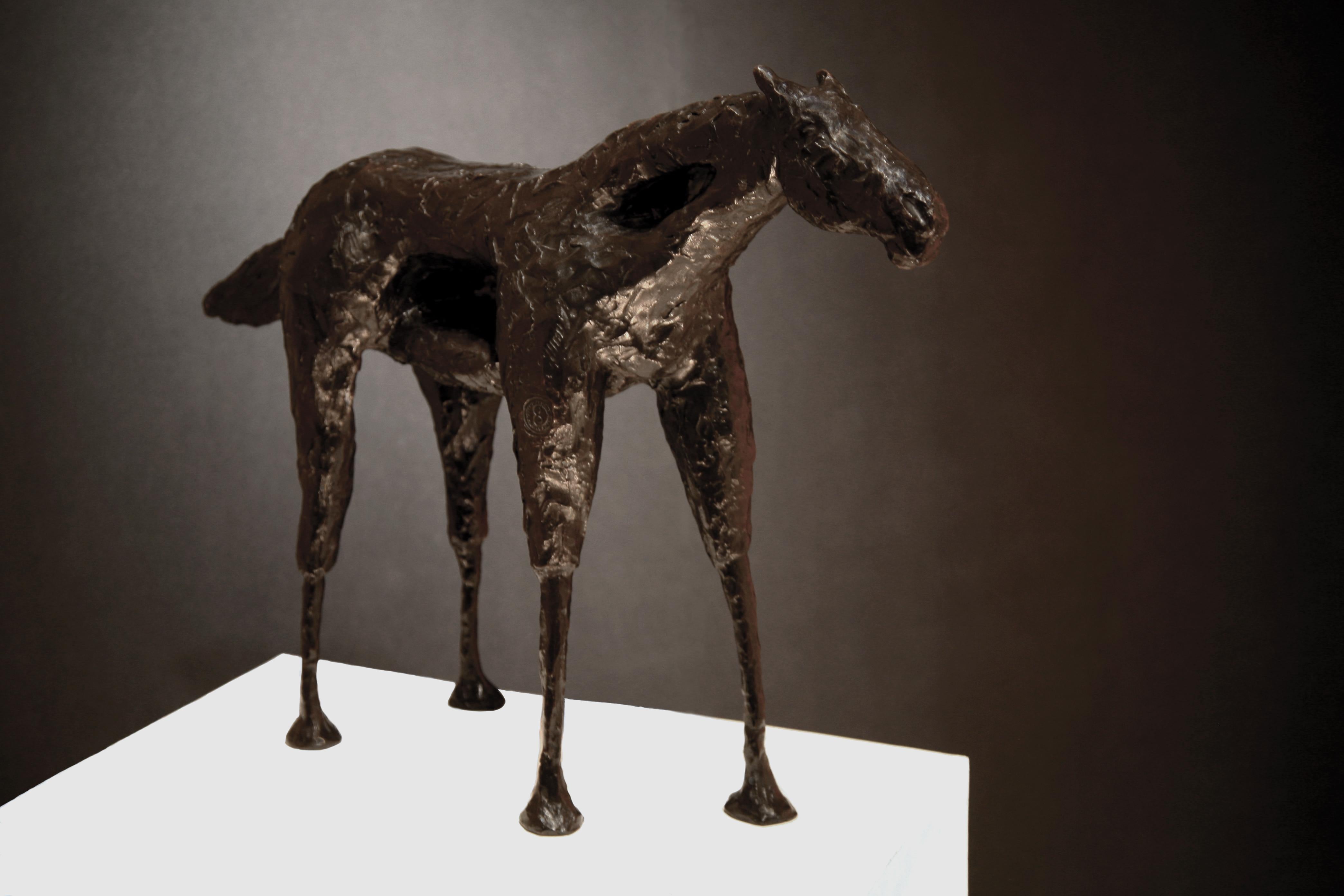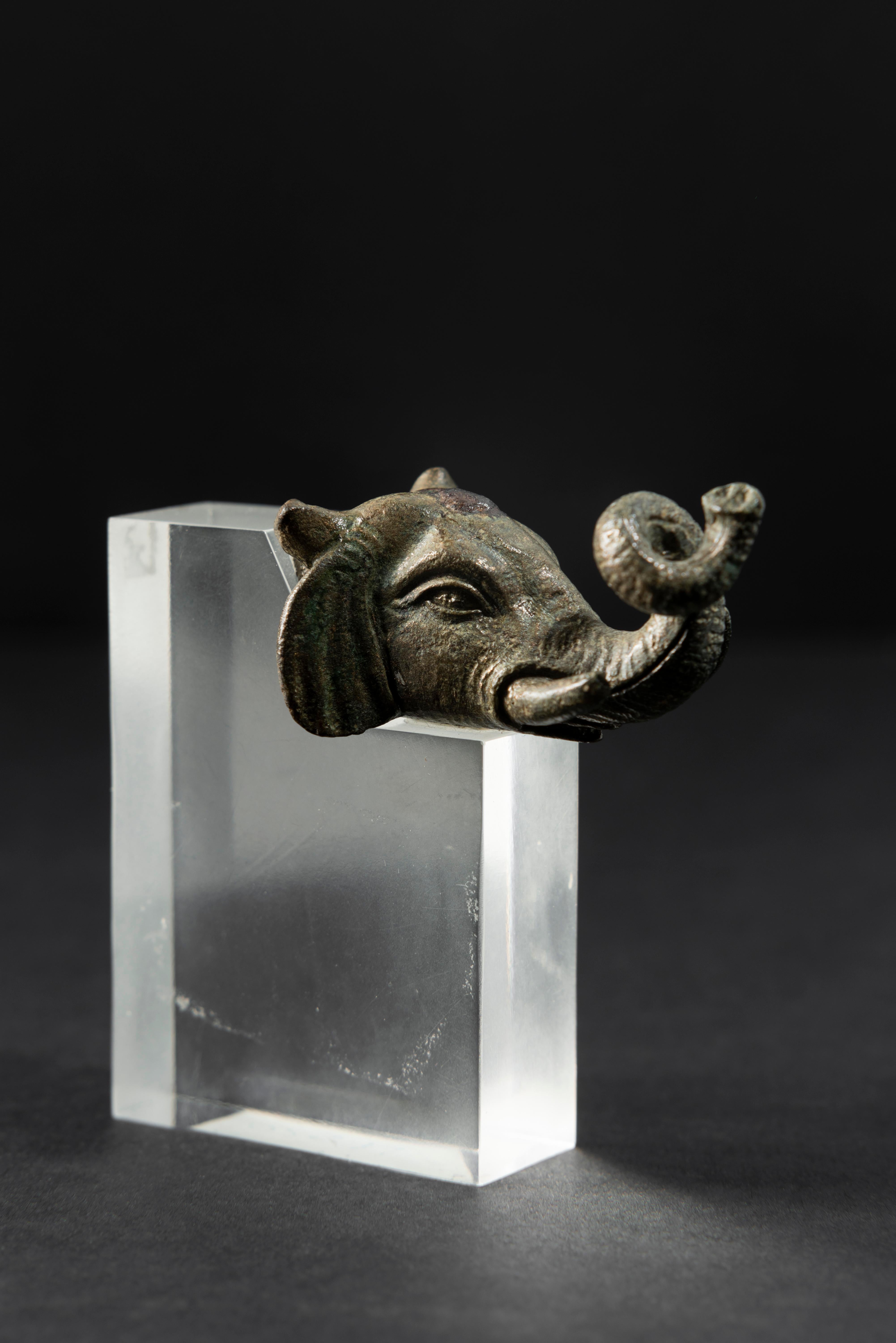Items Similar to Late 19th century Grand Tour bronze of the Dancing Faun
Want more images or videos?
Request additional images or videos from the seller
1 of 5
UnknownLate 19th century Grand Tour bronze of the Dancing Fauncirca 1880
circa 1880
About the Item
A 19th century 'Grand Tour' bronze figure of the Dancing Faun, standing on a bronze square plinth. The faun balances on his toes and pivots, his horned head raised, his hair wreathed with acorns. He is smiling lasciviously, flipping his tail, and snapping his fingers.
Height: 80cm
Plinth width 26 x length 28cm
The original dancing faun was discovered in October 1830, installed in the middle of an impluvium, the pool in the atrium, in the ruins of a grand Pompeiian house, destroyed by the eruption of Mount Vesuvius near Naples in 79CE. The house was named the House of the Faun after the statue, which, much like the great Alexander Mosaic from the same house, immediately became famous. Thought to be based on an earlier Hellenistic work, an English traveller in 1838 declared it 'the Venus de Medicis of Sylvans'.
In 1860, under Victor Emmanuel II, the antiquities from Pompeii were put on view for the general public in the National Archaeological Museum at Naples. Permits for taking molds from antiquities in order to copy them were soon granted to various individuals and institutions. The reproductions that these enterprises offered were often reduced in scale, making them easy for grand tourists to take home to northern Europe, Britain, and America.
- Creation Year:circa 1880
- Dimensions:Height: 31.5 in (80 cm)Width: 11.03 in (28 cm)Depth: 10.24 in (26 cm)
- Medium:
- Period:
- Condition:
- Gallery Location:Bath, GB
- Reference Number:1stDibs: LU95213893562
About the Seller
5.0
Vetted Seller
These experienced sellers undergo a comprehensive evaluation by our team of in-house experts.
Established in 2002
1stDibs seller since 2015
36 sales on 1stDibs
Typical response time: 1 hour
Associations
The British Antique Dealers' AssociationLAPADA - The Association of Arts & Antiques DealersInternational Confederation of Art and Antique Dealers' Associations
- ShippingRetrieving quote...Ships From: Bath, United Kingdom
- Return PolicyA return for this item may be initiated within 3 days of delivery.
More From This SellerView All
- French 19th century Animalier bronze of Two Hares on a naturalistic baseBy Alfred DubucandLocated in Bath, Somerset19th century bronze group of a standing and sitting hare by French animalier sculptor Alfred Dubucand (1823-1894). Finely detailed bronze with good dark brown patination. Signature '...Category
Late 19th Century Naturalistic Figurative Sculptures
MaterialsBronze
- French Animalier bronze of an Italian greyhound dog with a fanBy Pierre Jules MêneLocated in Bath, SomersetItalian greyhound in bronze ‘Levrier a L’Eventail’ with black patination by French sculptor Pierre-Jules Mêne (1810-1879). The dog, facing right with an open fan lying on the carpet...Category
Mid-20th Century Figurative Sculptures
MaterialsBronze
- A late 19th century bronze animalier figure of a seated houndBy Prince Paul TroubetzkoyLocated in Bath, SomersetA late 19th century bronze of a hound, seated on a naturalistic base, after Prince Paul Troubetzkoy. Incised to base 'Paolo Troubetzkoy 1893', with a dark brown patina. Born in 1866...Category
Late 19th Century Naturalistic Figurative Sculptures
MaterialsBronze
- A 19th century bronze sculpture of an Irish Wolfhound dogLocated in Bath, SomersetArthur Waagen (German 1833-1898): A 19th century bronze of the Irish Wolfhound 'Gelert', the base set with a scroll giving the dimensions and weight of...Category
19th Century Naturalistic Figurative Sculptures
MaterialsBronze
- A large late 19th century French animalier bronze of a recumbent greyhound dogBy Christophe FratinLocated in Bath, SomersetA large late 19th century bronze figure of a recumbent greyhound after French animalier sculptor Christophe Fratin (1801-1864), with a warm brown patina on a rouge griotte marble base. Signed 'FRATIN' on collar. Bronze length: 37cm Base length: 41cm Bronze height: 18cm Total height: 22cm Christophe Fratin was born in Metz in France in 1801. He first studied sculpture under Pioche in Metz under whom he honed his technical skills. He then became a pupil of the painter Theodore Gericault in Paris where he pursued his career as a sculptor. Fratin first exhibited at the Paris Salon as early as 1831, where he showed ‘Fermer – An English Thoroughbred’. The popularity of Fratin’s sculpture in England had a significant impact on his career. His modelling style reflected his imaginative mind and sense of humour, particularly in his humorous modelling of bears. Fratin was asked to sculpt life-size monuments for French cities, including his home town of Metz. At the Great Exhibition of 1851 in London he was considered the greatest animalier sculptor of the day. Fratin’s bronzes...Category
1880s Naturalistic Figurative Sculptures
MaterialsBronze
- A pair of late 17th century Northern European carved oak angelsLocated in Bath, SomersetA pair of carved oak angels, circa 1700, with a lovely warm patina and faint traces of polychrome to the face and gilding to the body. The angels are both kn...Category
17th Century Baroque Figurative Sculptures
MaterialsOak
You May Also Like
- Caballo Arroyo (Bronze horse sculpture by Frank Arnold)By Frank ArnoldLocated in Fresno, CAFrank Arnold is thought by many to be one of the foremost abstract figurative painters and sculptors of our time. He is a living master whose work is considered to be both personal a...Category
21st Century and Contemporary Abstract Figurative Sculptures
MaterialsBronze
- NeuvoaBy Frank ArnoldLocated in Fresno, CAFrank Arnold is thought by many to be one of the foremost abstract figurative painters and sculptors of our time. He is a living master whose work is considered to be both personal a...Category
21st Century and Contemporary Abstract Abstract Sculptures
MaterialsBronze
- Daniel Kafri, "Family", 1989, bronze sculpture, 27x17x19 cmLocated in Jerusalem, ILDani Kafri "Family", 1989 Bronze 27x17x19 cm On the last day of WW2, in Czechoslovakia – 1945, Daniel Kafri was born on the brink between mankind’s darkes...Category
1990s Figurative Sculptures
MaterialsBronze
- ANCIENT BRONZE HEAD OF AN ELEPHANT, ROMAN EMPIRE 2ND CENTURY ADLocated in Milan, ITThis beautiful cast bronze elephant head is a protome, which in ancient art was a decorative element consisting of a head - sometimes with part of the bust - of a human, animal, or f...Category
15th Century and Earlier Figurative Sculptures
MaterialsBronze
- ANCIENT ROMAN BRONZE FIGURE OF WINGED EROS RIDING A DOLPHIN, 2ND CENTURY ADLocated in Milan, ITBronze figure of a young Eros, caught in the pose of riding a dolphin. Attractive green patina, some fingers and right foot are broken. Separately worked left wing is missing. Right ...Category
15th Century and Earlier Figurative Sculptures
MaterialsBronze
- 16th Century Venetian bronze sculpture of a Young Man in ArmourLocated in Milan, IT16th Century Venetian bronze sculpture of a Young Man in Armour attributed to the Florentine artist Andrea di Alessandri, called Il Bresciano (Fl...Category
16th Century Figurative Sculptures
MaterialsBronze




